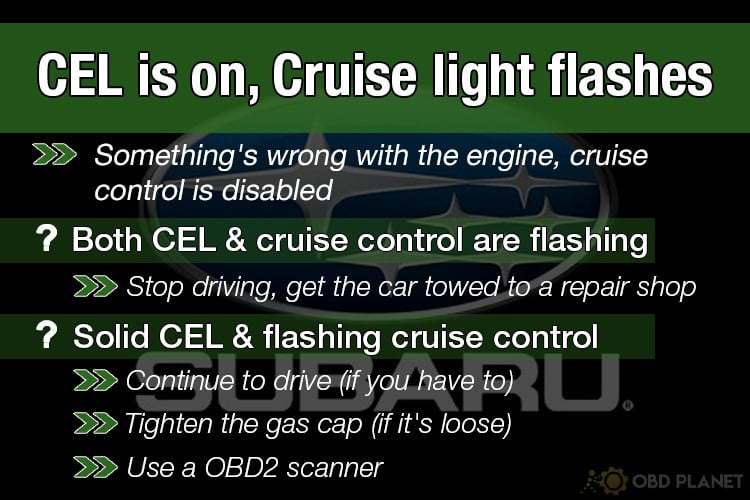Is the check engine light turned on in your Subaru and you’ve got a flashing cruise control light? Trying to search for an answer but can’t find any?
Don’t worry, I’ve got you covered!
An illuminated check engine light (CEL) is a sign of something wrong with your Subaru’s engine. When this happens, the cruise control light will start flashing as the vehicle will disable this function automatically. The traction control may also be disabled.
You need to get to the root problem immediately to prevent any further damages to the vehicle. These are the two situations you may encounter:
- Check engine light (CEL) and cruise control light is flashing
- A solid check engine light and a flashing cruise control

Both CEL and cruise control light are flashing
When CEL and cruise control light is both flashing, STOP driving immediately to prevent any further damage to the engine!
It’s a rare occurrence when both the lights are flashing. This usually means that the Subaru’s engine is misfiring.
Call a tow truck to get your vehicle to the nearest mechanic for a quick inspection and repair job.
Solid CEL & flashing cruise control light
A solid CEL and a flashing cruise control light is a very common problem faced by Subaru owners.
When this happens, don’t panic!
You can continue driving your car, however, it is best to have it checked asap to prevent further wear and tear.
So, what could be causing a solid CEL and a flashing cruise control light?
Check gas cap first
The first thing you should do is check the gas cap. Tighten the cap if it is loose. In case the cap is faulty, getting a new cap is the option.
Your Subaru car is equipped with a computer (ECU) that detects drops in pressure in the gas tank. A loose or open gas cap will reduce the pressure in the tank resulting in a solid CEL.
If you find that the gas cap is already tight, there may be other problems. And you have to use an OBD2 code reader to figure out what’s wrong.
How to diagnose your Subaru using a code reader
Investing in an OBD2 code reader is never a bad choice. The tool will tell the Diagnostic Trouble Code (DTC), which indicates your car problems. Most of the time, fixing these DTCs is quite simple. But sometimes, you still have to bring the car to a repair shop.
The problem is that some mechanics might exaggerate problems with your vehicle in the hopes of making more money. In that case, a code reader can help you identify the real issues and avoid being ripped off by mechanics.
Whether you’ve got an Outback, Legacy, or any other Subaru model, these OBD2 code readers can totally work for your car.

Ancel AD310

Foxwell NT201

Autel MS309
Once you’ve got yourself a code reader, this is what you do.
- Locate the OBD II data link connector (DLC), a two-row 16 pin connector.
- Connect the DLC with your OBD II scanner.
- Turn the key to the “on” position and switch the OBD II scanner on.
And you’re done!
Let’s quickly go over the common problems you can have with your Subaru. We will discuss:
- Possible causes
- Symptoms
- DTCs
- Repair cost
Please do note that I will provide you with the most common problems I’ve experienced with Subarus that come to my garage. These problems may be common across other models so I won’t repeat them for different Subaru models. If you have other issues, leave a comment below!
Let’s get started!

Subaru Outback common problems causing CEL & flashing cruise
Vibration on acceleration
A shaky Subaru during acceleration means that the engine is not getting enough power.
In this case, there can be many things causing this problem, and these two are the most common:
- Vacuum leak
- Bad spark plugs
| Possible causes | Other signs | DTCs | Fixing cost (labor included) |
|---|---|---|---|
| Vacuum leak | Hissing sound Poor fuel efficiency Poor engine performance Failed emissions | P0171 P0174 | $80-$110 |
| Bad spark plugs | Long cranking time Poor fuel efficiency Rough acceleration | P0300 P0301 P0302 P0303 P0304 | $40 - $150 |
Bad O2 sensors
The oxygen sensor is responsible for checking the air and fuel ratio. It adjusts it accordingly by sending signals to the ECU.
To check for a bad O2 sensor, go to “Live Data” >> “O2 sensor output voltage”.
If you see a flat line, that sensor needs replacing. There are a few different sensors in bank 1 and bank 2, make sure you check them all.
Besides, bad O2 sensors can throw these DTCs:
- P0138
- P0135
- P0150
- P0155
- P0156
- P0161
- P0162
- P0167
You can also keep an eye out for the following symptoms:
- Poor fuel efficiency
- Rough idling
- Failed emissions
Having a mechanic replace O2 sensors will cost you about $250 – $500. However, this is quite easy to do, you can totally do it at home for about $50 – $250.
Blown head gasket
Subarus after the 1990s were known for their head gasket problems. Head gaskets are a seal between the engine block and the cylinder. This helps prevent any engine oil and coolant leakages.
An overheated engine can damage the head gasket. It’s always best to look out for the following signs of blown head gasket:
- White smoke from the tailpipe
- Milky coolant
- Lower coolant levels
- Oil leakages
- Overheating during different conditions
You can either have an issue with the cooling system or would need to replace different components. This will be an expensive repair.
Depending on the model of your Subaru, expect to pay $2,500 – $2,700 for replacing the head gasket and an additional $700 for other small components.
You may even be charged upwards of $5,000 by mechanics if a lot of replacement is required!
There are a lot of issues that can occur with head gaskets. I have written a whole article about the blown head gasket. Click to learn more.
Subaru Forester common problems causing CEL & flashing cruise
These 2 common problems Subaru Forester vehicles share with the Outback models.
- Bad O2 sensors
- Blown head gasket
Besides, a bad catalytic converter is also a very common issue Subaru Forester car owners often encounter.
Failed catalytic converter
The catalytic converter doesn’t usually go bad on its own. It is external causes that can impact your catalytic converter. The code P0420 will indicate that your Subaru has a failed catalytic converter.
A failed catalytic converter must be investigated to determine the root cause. Here are a few signs to help you identify a failed catalytic converter.
- Rough running of the engine
- Bad smell from the tailpipe
- Converter rattles during idling
- Glowing red catalytic converter
- Engine losing power
- Poor fuel economy
A failed catalytic converter will result in a failed smog test. You won’t be able to drive your vehicle once that happens.
Replace your catalytic converter immediately. It will be around $940 – $2500.
Subaru Legacy common problems causing CEL & flashing cruise
Subaru Legacy vehicles also have the same common issues as with the Forester and Outback.
● Bad O2 sensors
● Blown head gasket
Subaru Impreza common problems causing CEL & flashing cruise
Bad O2 sensors are an issue Subaru Impreza owners often encounter. Another common problem is faulty knock sensors.
Bad knock sensors
Knock sensors help detect engine detonation. The sensors send engine knocking signals to the powertrain control module (PCM) to prevent this from happening.
Faulty knock sensors can be caused by:
- High intake temperatures
- Lower fuel quality
- Carbon buildup
- Bad ECU calibration
With bad knock sensors, you may face issues during driving. Check out for the following symptoms of bad knock sensors:
- Knocking sounds
- Poor fuel efficiency
- Low engine power
- Failed emissions
Your OBD2 scanner should give you the codes P0325 or P0332 when your car has faulty knock sensors.
Replacing the sensor would run you a total of $100 – $550 (with labor cost).
Other common fault codes on Subaru
If none of the above cases is your problem, let’s look at other common fault codes on Subaru.
Note: Sometimes one code could mean multiple problems. So, for a DTC, I may show you more than one solution.
| DTCs | Possible causes | Repair cost (labor included) |
|---|---|---|
| P0026 & P0028 | Dirty engine oil Low engine oil Faulty intake valve control solenoid | Replace faulty intake valve control solenoid: $125 - $450 Replace engine oil: $35 - $75 |
| P0442 | Loose fuel cap Fuel tank/fuel hose leak | Replace gas tank: $1,100 - $1,200 Repair leaks: $200 |
| P0700 | Faulty camshaft position sensor Faulty PCM Faulty crankshaft position sensor | Replace TCM: $500 - $900 Replace transmission: $1,200 - $5,000 Replace transmission fluid: $80 - $250 Replace solenoid: $150 - $400 (Single unit) Repair valve body: $320 - $900 |
| P0340 | Faulty camshaft position sensor Faulty PCM Faulty crankshaft position sensor | Replace camshaft position sensor: $95 - $200 Replace PCM: $500 - $1,500 Replace crankshaft position sensor: $120 - $300 |
Conclusion
Subarus (especially older variants), although notorious in many parts of the world, are not always the most reliable of cars. However, different models are similar in technology which can help in diagnosing the issues easier.
You may face other issues not mentioned in this article. There are a bunch of things that Subaru owners can face. To help Subaru owners, I have listed the potential and most common problems many mechanics and myself have encountered over the years.
And finally, whatever codes and symptoms you may have, don’t forget to leave a comment below. I’m always here to help!


